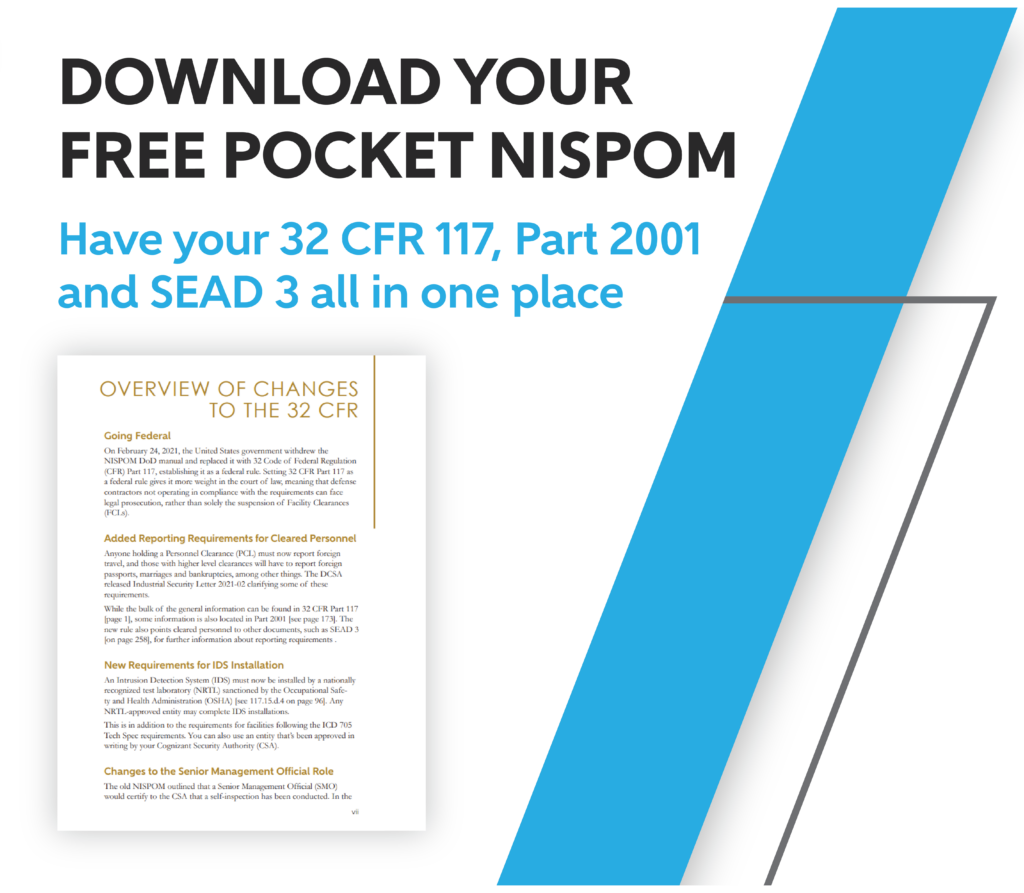How these two forms relate to your FCL, plus common mistakes in filling them out
Both the DD 441 and SF 328 are important forms for obtaining your Facility Clearance (FCL). On their face, they’re short and straightforward documents that you should be able to fill out with relative ease. However, that doesn’t mean they can be written off as something that you don’t need to pay attention to. There are common mistakes made when filling out these forms, and making them can delay your FCL or cause issues with your clearance. First, it’s important to make sure you understand these forms’ purpose for obtaining your FCL.
DD 441 Overview
The DD 441 form, or the Department of Defense Security Agreement, is an agreement between the U.S. Government and your facility, like an NDA. Both the DD 441 and the SF 328 will be completed by your company’s Senior Management Official (SMO), likely the company’s president or CEO, and will require a witness, who can be either cleared or uncleared.

The form outlines security expectations that your facility is expected to uphold in order to access classified information, though the exact requirements are expanded on in other documents, mainly the 32 CFR Part 117, NISPOM. This must be submitted as part of your initial FCL package. You will also complete it again in the case of a change in SMO or if you’re seeking to upgrade your clearance level.
SF 328 Overview
The SF 328, or the Certificate Pertaining to Foreign Interests, is where you outline your company’s Foreign Ownership, Control or Influence (FOCI). This form lists 10 yes or no questions that you answer to disclose if your company has any relationship with a foreign entity. Any yes answers indicate you are under some level of FOCI, and you expand on these answers in the remarks section.
Like the DD 441, you will fill this form out again if you have a change of SMO or are upgrading your clearance. For this form, you will also redo it if your company has a change of FOCI, like if your company is acquired by a foreign company.
A relationship to certain countries that the U.S. has poor diplomatic relations with, like Russia, will cause your clearance to be rejected entirely. If a foreign entity owns less than 5% of your company, it’s unlikely you fall under FOCI—depending on which country holds ownership.
When you submit this form, it needs to be reviewed by the FOCI Mitigations Office along with DCSA. This can make the review of your submission take a bit longer if you answer yes to any questions. They need to determine what level of FOCI you would fall under and what mitigations would therefore be necessary. FOCI is decided on a case-by-case basis, so there’s no guaranteed way to know what mitigations you’ll be required to have.
Common Mistakes
Both the DD 441 and the SF 328 can be relatively quick to complete, but any mistakes will cost you time, especially if you are applying for your initial clearance. The biggest risk with these forms is not taking them seriously and making careless mistakes. If you want to avoid delays and make sure you’ve completed the forms correctly, watch for these common mistakes.
One issue people often run into on both forms is not making sure the SMO’s title matches in both places where it needs to be written: It should be written exactly the same in the Authorized Contractor Representative line and next to “the Contractor Representative certifies that he or she is the (title).” If the title is not exactly the same in both areas where it needs to be listed, that will cause your form to be rejected. This is true even in small differences, such as if you write “company president” in one spot and just “president” in the other.
On the DD 441, in the section at the top where there is a space for the date, do not fill that out. That will be filled out by your DCSA rep when they review the form. Filling it out will lead to your form being rejected.
Besides making sure the titles match on the signature portion of the form, the SF 328 is typically pretty simple to fill out. Make sure you’re honest on it, and explain any yes answers fully in the remarks section. It’s never a good idea to try to hide something on a form like this—you will be found out.
DCSA will typically prefer a digital signature on these documents. If you do a wet signature, the DCSA will need the original signed copy mailed to them so they can sign the original. If you choose a wet signature and if there are any issues with your form, know that you’re multiplying the potential delay since you have to wait for the document to arrive.
If you are completing these forms due to a change condition, like a new SMO, you can typically expect to hear back from DCSA within a week whether the forms have been approved or if something needs to be fixed. If the documents are submitted as part of a larger initial clearance package, it will take longer to hear back, closer to a month, since DCSA needs to evaluate the complete package.
Government work often involves a lot of tedious paperwork, and it can become all the more frustrating if mistakes are made and you have to complete the same form more than once. If you’re looking for some guidance to make sure you’re getting it right, Adamo’s FSO Support team can help. From managing your PCLs to running annual trainings to preparing you for inspections, we can assist with it all. Reach out today for a quote.




